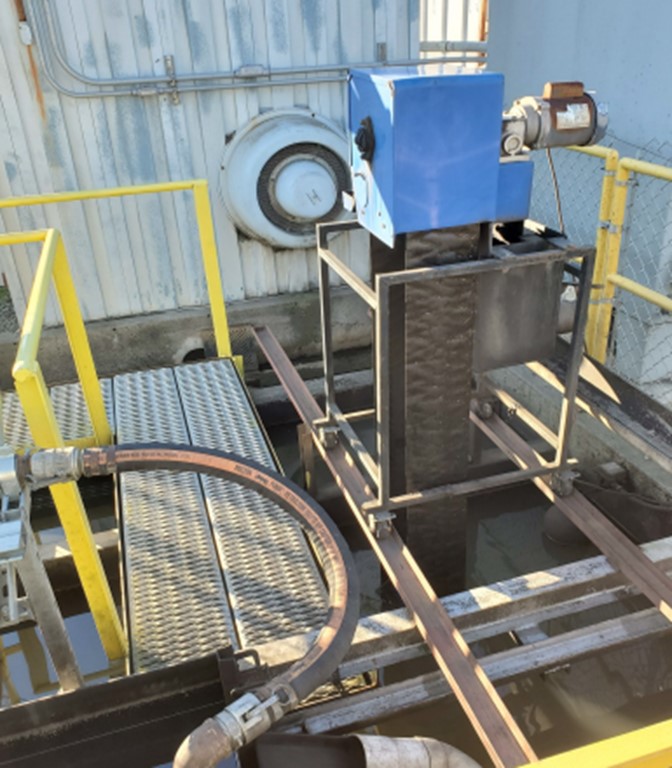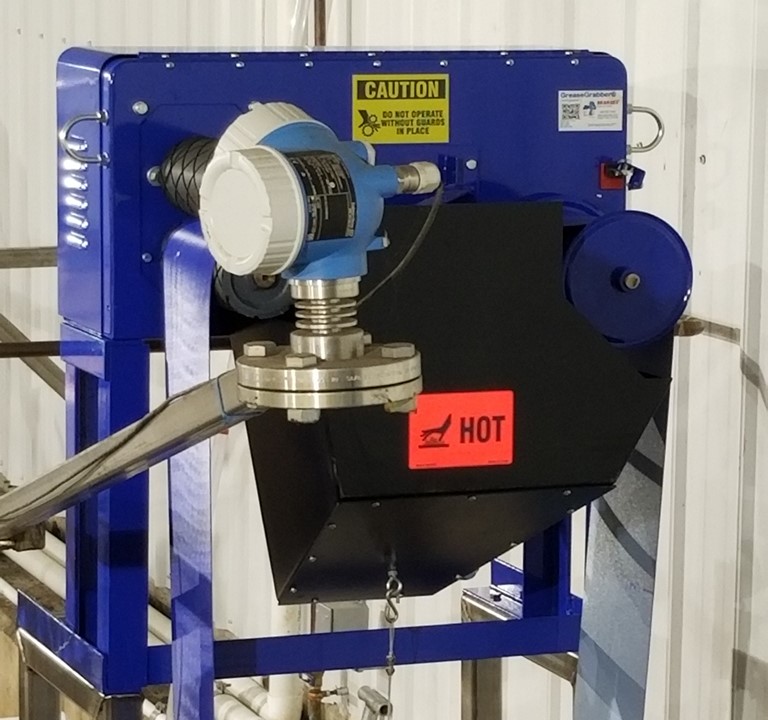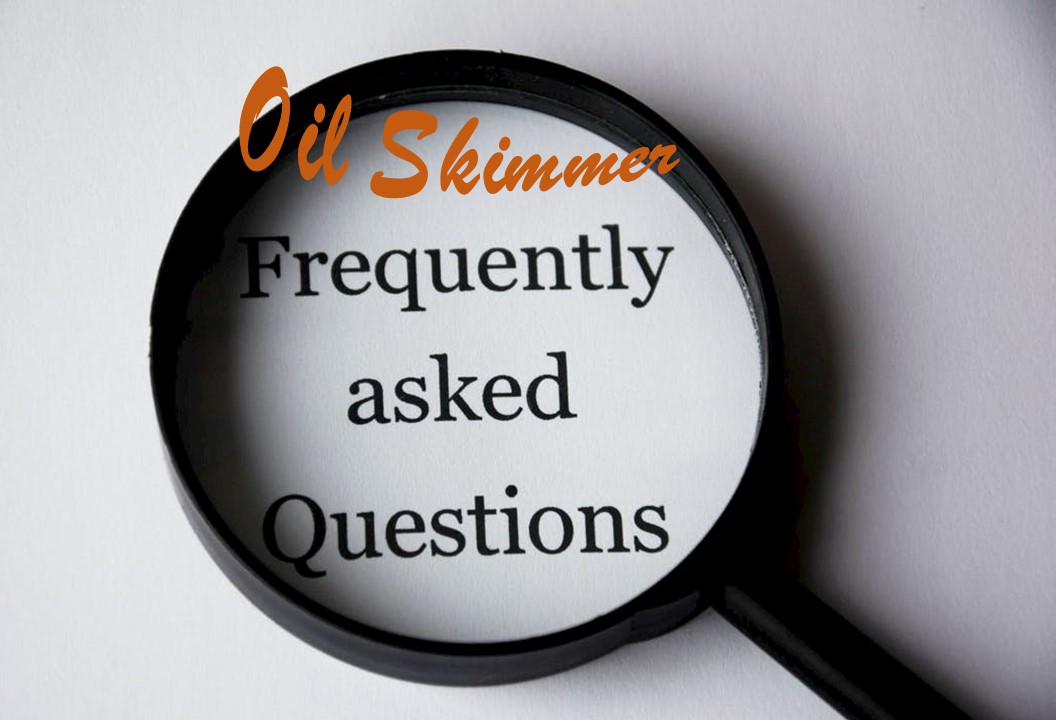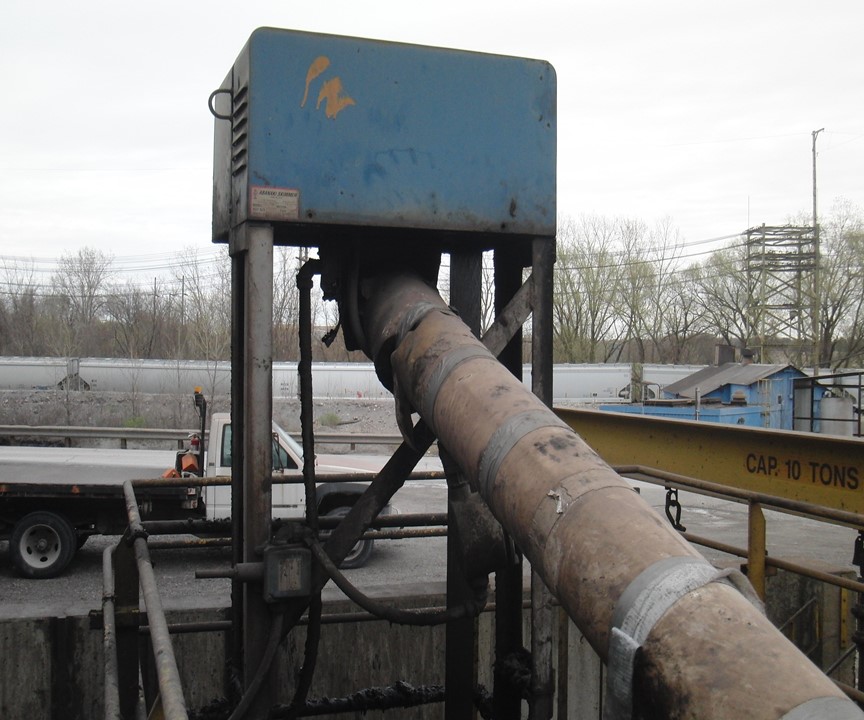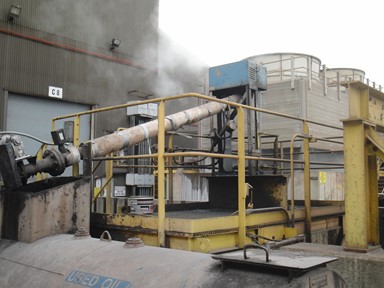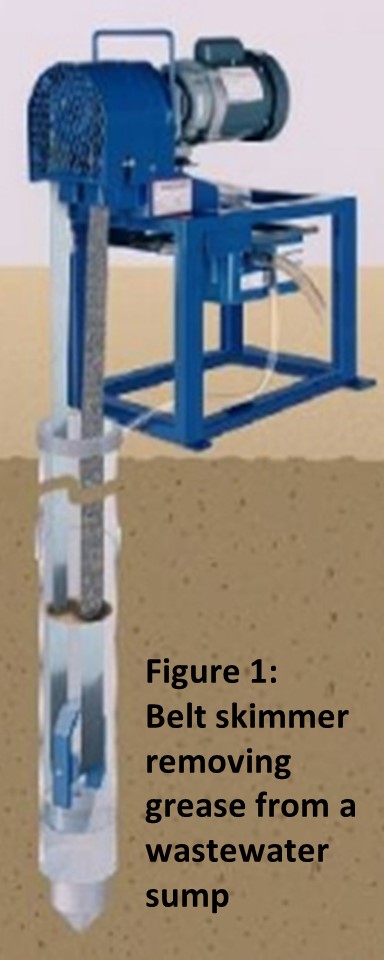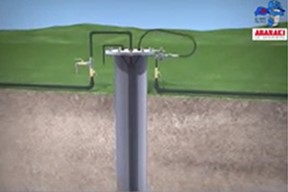There are several things to consider when choosing a belt or tube material for your oil skimmer. Some plastics will not stand up to heat or strong chemicals. Certain metal belts will not skim coolants effectively. Smooth belts do no pick up floating emulsified oils. Specific plastic belts do not last in heated applications, while other types of plastic belts will.
Topics: oil skimmers, belt skimmer, oil concentrator, tote-it, belt oil skimmer
What is the maximum amount of oil to be removed, and the shortest period of time available to do it? Capacity should be based on the maximum amount of oil to be removed within the shortest available time. For instance, total oil influx may be 200 gallons in a 24-hour period, which averages about 8.3 gallons per hour. But if most of it comes during a single 8-hour plant shift, you will probably need a removal rate that is three times as high, especially if you are trying to prevent an unwanted discharge of contaminated water to a sewer system. As a rule-of-thumb, specify approximately twice the maximum capacity you anticipate needing for normal conditions.
Oil Skimmer Belt, Tube, and Disk type
Capacity is not affected by length. Choose a length that: assures contact with the liquid at its lowest level; allows easy mounting of the oil skimmer where oil discharge is convenient; and has good access for routine service. Abanaki’s ability to supply oil skimmers with long belts, and lift skimmed oil well over 100 feet with no loss in capacity or efficiency, is important to many users.
The chart below indicates the appropriate belt for the most common applications. The guidelines below are general, actual performance of the belts will depend on the variables of each application. Heat, for example, increases a belt’s sensitivity to pH levels.
Wiper Blades
Abanaki offers different materials to suit a variety of operating conditions. The standard is Nitrile (also known as Buna-N), which is appropriate for about 80% of all applications. Optional materials are designed for applications with harsh operating conditions. The materials include: CRV (very high chemical resistance), ceramic hybrid (excellent lubricity and moderate chemical resistance), and stainless steel wipers.
What type of wiper blades are the best? The charts below illustrate characteristics of each material.
Motor Types
All Abanaki oil skimmers are designed with standard, industrially rated, continuous duty motors and fully enclosed speed reducing drives. Most of these oil skimmers can be specified with the following motor options:
- Any standard or exceptional electrical requirement
- Explosion proof
- Drip proof
- Tropicalized
- Dirty duty
- Food service
- Wash down duty
- DC motors
- ATEX/European motors
What type of motor do you require? The following are the standard motors available with Abanaki belt oil skimmers:
Optional Components
Abanaki offers various options to adapt to different applications. Some of the most common options are listed below:
- Mounting Stands
- Concentrators
- Heated Decanter
- Yokes and Chains
- Heater Hood for Outdoor
- Belt Retainer
Understanding and choosing the appropriate oil skimmers components can be difficult. If you are faced with an unusual requirement, contact us about the availability of special motors, controls and drive components.
To learn more about oil skimmers, please contact our experts at 440-543-7400 or visit our website: www.abanaki.com
Abanaki Model 8 Belt Skimmer in Operation
Topics: oil skimmers, belt skimmer, oil skimming, belt oil skimmer
Oil Skimmer Frequently Asked Questions: Part 1 | Abanaki
How Do You Know What Size of Oil Skimmer You Should Purchase?
Oil skimmers operate with a very basic principle. That basic principle is the breaking of surface tension to attract oil to the belt or tube. Because of this design, it is critical to size the oil skimmer according to the surface area being skimmed rather than the amount of oil in the tank.
For example, you could have a tank or pit that measure 144 square feet but only contains 2-4 gallons of oil at any particular time. Sizing the oil skimmer according to 2-4 gallons versus the surface area would yield unproductive results. Yes, you may only have small amounts of oil, but if your oil skimmer is undersized, that oil skimmer will not have enough power to break the surface tension with enough force to bring oil from the other side of the tank.
Therefore, you could run the oil skimmer for days and never retrieve the oil from the far side of your collection point. Always take into account how large of an area you want to skim oil from when determining what oil skimmer will work best for your application.
What are the general questions you need to know about your application?
There are a few things to consider when choosing an oil skimmer for any application. The most important thing is to pick an oil skimmer that is suited for the size of the application and the correct belt type. The questions below will help narrow it down:
- What is the size of the tank or sump you wish to skim from?
- What is the type of oil you are looking to remove?
- What amount of oil do you need to remove?
- What is the point of access on the tank or sump?
From here you can either use our oil skimmer selection guide or call your Abanaki representative at (440) 543-7400 to help point you in the right direction.
To learn more about oil skimmers, please contact our experts at 440-543-7400 or visit our website: www.abanaki.com
Learn how Abanaki oil skimmers help you save by "taking just a little off the top."
Selecting and sizing your next oil skimmer correctly is important – the wrong decision can cost your facility thousands over the long term.
Topics: oil skimmers, belt skimmer, oil skimming, belt oil skimmer
7 Common Mistakes That Lead to the Wrong Oil Skimmer | Abanaki
Selecting an oil skimmer can be a complex decision-making process. There are various factors you have to consider about your application when choosing the right skimmer. Here is a guide to help you avoid the 7 common mistakes that are made when purchasing an oil skimmer.
Under-Sizing Your Skimmer
Improper Placement of Oil Skimmers
Planning is important! Before spending money on a concrete pad and mounting arrangements, check where the oil actually collects in your process. Oil skimmers should be located opposite from the inflow and the tail pulley should be submerged two inches below the surface of the liquid in order to be as effective as possible.
Paying for a Complicated Solution
Oil skimming usually beats ultra-filtration systems in many applications. More often than not, installing large, complicated systems to remedy oil problems will not provide ideal results. You can save costs by using a relatively inexpensive oil skimming system to handle the free-floating oil and then a smaller treatment system to handle the oil that has remained suspended in the wastewater.
Not Telling Your Consultant or Vendor Everything
Oil skimmer selection can be a very complex process. There are numerous factors that go into selecting the right oil skimmer for your particular application. If the oil skimmer vendor does not know what chemicals or heat you have in your application, the wrong oil skimmer and belt materials could be selected, and the job will not get done correctly.
Choosing the Wrong Oil Skimming Material
There are several things to consider when choosing a belt or tube material for your oil skimmer. Some plastics will not stand up to heat or strong chemicals. Certain metal belts will not skim coolants effectively. Smooth belts do no pick up floating emulsified oils. Specific plastic belts do not last in heated applications, while other types of plastic belts will.
Lack of Maintenance and Basic Care
An oil skimmer will only remove oil if it is properly maintained. There are basic maintenance tasks that should be done regularly to keep your oil skimmer up to snuff. Are the wipers contacting the belt smoothly? Is the belt riding away from the sides of the pulley? Are the troughs and wipers clear of debris?
Buying from an Unknown Vendor Based on Price
Like most things in life, you get what you pay for. Buying from small, unheard of oil skimmer manufacturers will probably result in no customer support when maintenance issues pop up and little to no knowledge of how to resolve those issues. Furthermore, parts will need to be replaced over time, units might have to be changed or upgraded, or different belt materials need to be used. Disreputable vendors typically do not have a selection of materials or parts to choose from.
To learn more about oil skimmers, please contact our experts at 440-543-7400 or visit our website: www.abanaki.com
HOW TO TELL WHAT SKIMMER YOU NEED FOR YOUR MACHINE COOLANT
Have you ever looked at your coolant and wondered what type skimmer would work best in your machine sump? In this video, we talk about what oil skimmer works well in various coolant applications.
Topics: oil skimmers, belt skimmer, oil skimming, petroxtractor, belt oil skimmer, well oil skimmer
The Scoop on Oil Skimmers: Ensure Your Application Applies | Abanaki
When properly selected and applied, oil skimmers are highly economical solutions for separating oil from water to allow its reuse or safe disposal. However, there are certain applications that can expect optimal results. Typical applications best suited for oil skimmers encompass:
Wastewater Sumps
Wastewater sumps where removing floating hydrocarbons can reduce the cost of disposal and lower the contingent liabilities of wastewater discharge.
Most manufacturing or processing facilities have water systems where waste oil collects in a central tank or sump. Skimming the floating oils with little water content can reduce the cost of disposal and lower the contingent liabilities of wastewater discharge.
Coolant and Cutting Fluids
Coolants and cutting fluids where skimming tramp oils extends coolant life, improves the quality of machined parts, reduces irritating smoke that forms during machining, lessens the chance of dermatitis and helps prevent the fluid from developing a "rotten egg" odor.
Oil skimmers utilize the differing specific gravity between oil and coolant/water to remove tramp oils. A motor driven belt that is typically constructed of an oleophilic, or oil attractant material, is placed into a coolant sump or reservoir. As the belt moves through the coolant, it attracts tramp oils. The oil is scraped off by a wiper and deposited into a container.
Heat Treating
Heat treating operations where trench oils must be removed from heat-treated parts, and can be captured with a skimmer for re-use or disposal. This reduces oil purchases, prolongs wash water life and lowers disposal costs.
Parts Washers
Parts washers where removing floating oils from a wash tank prevents re-contamination of the parts as they are removed from the fluid and extends fluid life.
Industrial parts washers, paint lines, and machine shops all have a need to remove oil from water. Abanaki oil skimmers are trusted throughout the automotive industry to extend coolant life, reduce disposal costs, and avoid fines from municipal sewer districts.
Food Processing
Food processing facilities where the removal of vegetable oils, greases and animal fats from a plant's wastewater stream reduces processing and disposal costs.
Oil skimming is the most reliable and lowest cost method of removing food greases and oils from process wastewater. An oil skimmer uses the difference in specific gravity between oil and water, allowing the oil skimmer belt to attract frying oils, vegetable oils, greases, and animal fats as the belt passes through the surface of the water. The simple belt-and-motor approach is proven to operate unattended and reliably for decades with little maintenance.
Parking Lots, Garage and Service Facilities
Parking lots, garages and service facilities where waste oil from leaks, spills and other sources must be retrieved from sumps before water can be discharged to storm or sanitary sewers.
Outdoor Ponds, Lakes and Basins
Outdoor ponds, lakes and basins where floating oils are present, skimmers provide inexpensive and effective removal, solving a serious environmental problem.
Recovery/Monitoring Wells
Recovery/monitoring wells where a belt skimmer can be used instead of a down well pump to remove oil, fuel and other hydrocarbons. Generally, this is more cost-effective and reduces maintenance headaches. Skimmers can reach depths of 200 feet or more and remove floating products despite fluctuating water tables.
The PetroXtractor is a well oil skimmer that makes use of the differences in specific gravity and surface tension between oil and water. These physical characteristics allow the unit’s continuous belt to attract floating oil in the well. After picking up the oil, the belt travels over the head pulley on the drive unit and through tandem wiper blades. The oil is then scraped off both sides of the belt and discharged through a 1-1/4″ ID hose. The unique bearing-less design of the tail pulley (immersed in the well water) with its tethered frame allows it to perform three important functions: it keeps proper tension on the belt, prevents accidental loss down the well, and keeps the belt centered in the casing.
Remediation Processes
Remediation processes where skimmers can be used effectively in tandem with other means and reduce the overall cost and increase the speed of the cleanup. For example, when using bio-remediation techniques, skimmers can be used to first remove the bulk of the oil from the groundwater. Then more biological agents may be used to clean up the remaining contamination. The remaining oil will clean up faster, as there will be less of it.
Sometimes called pump-less groundwater remediation systems, oil skimming is the lowest cost way to remove hydrocarbon contamination from groundwater. Oil skimming alone may clean water to acceptable levels or be used as a pre-filter treatment. It is the most inexpensive way to remove LNAPLs or DNAPLs.
To learn more about oil skimmers, please contact our experts at 440-543-7400 or visit our website: www.abanaki.com
Oil Skimmers Get the Dirty Jobs Done
In the video, oil skimmer is shown removing spent lubricant from a collection tank in a steel production facility. Due to the extreme heat resulting from the steel making process, lubricant used for conveyor bearings often leaks into the cooling water, creating a floating goop that can foul filters further upstream.
Topics: oil skimmers, belt skimmer, oil skimming, coolant maintenance, coolant skimmer, belt oil skimmer, oil skimmers applications
The Scoop on Oil Skimmers: Consider All the Options | Abanaki
All moving media skimmers use motors to move the belt, tube, disk, etc. While many are designed with standard, industrially rated, continuous-duty motors and also may use fully enclosed speed reducing drives, some can be specified with a number of motor options. These may include:
- Any common voltage or electrical requirement
- Explosion proof
- Drip proof
- Tropicalized
- Dirty conditions duty
- Food service duty
- Water wash-down duty
Consider also any optional equipment that may be available with the skimmer you are evaluating. Accessories allow customized systems that can ease installation and optimize performance. Some of the more common options include:
- Special Drive Components. Tail Pulleys can help improve removal rates by stabilizing belt assemblies in the fluid. Yoke-and tether assemblies help prevent pulley loss due to human error or belt breakage.
- Mounting Stands and Adapters. These include pre-engineered mounting stands for easier installation. Models also are available for pits, walls and free-standing units.
- Shelters/ Enclosures. Reinforced poly-shelters and below-grade enclosures provide protection from the elements.
- Controls/Accessories. A float switch and warning light can be used to monitor fluid level in the oil collection drum, which helps prevent overflow. Other options include a timer, control panel, variable speed drive and power packs.
- Concentrator. Generally, the ratio of water to oil decreases with thicker films of floating oil and slower moving pick-up media. A concentrator or decanter installed at the skimmer discharge port provides secondary oil/water separation that can reduce water content to nearly zero.
- Heaters. Many skimmers can be ordered with heating devices to keep skimmed product fluid in cold environments.
To learn more about oil skimmers, please contact our experts at 440-543-7400 or visit our website: www.abanaki.com
How to Skim Oil from Coolant Using Tube Skimmer
A tube oil skimmer can be used on machining centers with little or no access to the coolant sump from above. Plus, a tube oil skimmer can remove oil from chip conveyors or enclosed machining centers.
Topics: oil skimmers, belt skimmer, oil skimming, coolant maintenance, coolant skimmer, belt oil skimmer
The Scoop on Oil Skimmers: Determine the Right Design | Abanaki
For industrial oil skimming, there are six basic designs commonly used in moving media skimmers. (Suction skimmers are excluded, as they are generally unsuitable except for relatively thick (1/4 inch) layers of oil; otherwise they tend to ingest large amounts of water.)
In more demanding situations, skimming is a cost-effective means of removing most of the oil before using more complicated and costly treatments, such as coalescers, membrane filters and chemical processes.
Belt-Type Skimmers
Belt-type skimmers use an endless belt of stainless steel, elastomer or polymer medium, which is lowered into the tank or vessel to be skimmed. The belt passes through the fluid, and then through the skimmer's resilient wiper blades where the oil is removed from both sides of the skimmer medium. Removal rate is not affected by belt length. The length is chosen to ensure contact with the liquid at its lowest level. The belt length should also allow easy mounting of the skimmer where oil discharge is convenient, and assure easy access for routine service. Lengths up to 100 feet or more are possible.
Mop Skimmers
Mop skimmers use an endless medium shaped like a rope that has mop-like tendrils that pick up the oil. As the medium leaves the liquid and enters the drive unit, it is pressed and wrung out with pinch rollers. For higher viscosity oils, this medium tends to mat down and lose effectiveness. Generally, a decantation system must be used with these units, as water pickup can be quite high. Also, replacement mops tend to be more expensive than belt type media.
Large Tube Skimmers
Large tube skimmers use a floating plastic hose that snakes out over the surface of the liquid and is then drawn back through the drive unit where oil is removed. This design requires a relatively large amount of fluid surface area for proper operation. Length considerations are the same as for belt skimmers; a typical tube diameter is 1 inch.
Mini Tube Skimmers
Mini tube skimmers are very similar to the larger tube units, but typically have either a 3/16-inch or a 5/16-inch diameter tube. The 5/16-inch diameter is preferable as it has enough stiffness to not drag on the housing and prematurely wipe off oil when drawn into the unit. Pickup rates vary from 1 quart/hour to 1.5 gph, depending on diameter and speed. These units can be used where space is limited. Units that have the motor mounted underneath reduce the amount of space required over the rim of the tank to nearly zero.
Disk Skimmers
Disk skimmers rotate a disk-shaped medium through the liquid. Oil is wiped off and discharged into a collection container in a manner similar to belt skimmers. When specifying disk diameter, it is important to consider reach, the portion of the disk that actually gets immersed. Less disk area in the fluid means less oil removed. Obviously, fluctuating fluid levels can be a real problem.
Also, it is important to look at how much of the disk the wipers are actually wiping. If they wipe only 2 inches from the edge, then any reach into the fluid beyond 2 inches is wasted. As a result, removal capacities for disks can be relatively low.
Drum/Barrel Style Skimmers
Drum/barrel styles are similar to the disk type, but use a rotating drum-shaped medium. Compared to disk types, they are usually more rugged and have higher removal capacity. These units can also be rendered ineffective by fluctuating fluid levels.
When properly selected and applied, oil skimmers are highly economical solutions for separating oil from water to allow its reuse or safe disposal.
All of our coolant skimmers are rugged, reliable and low maintenance. Removal capacities range from 1 to 200 gallons per hour. Browse the types of oil skimmers and oil skimming accessories in our website www.abanaki.com or contact our experts at 440-543-7400 to find the right solution for your application.
Unfamiliar with our Oil Skimming products? Go to the Skimmer Selection page to view the types of oil skimmers for every application.
Watch this video to see how do industrial belt skimmers work.
Topics: oil skimmers, belt skimmer, oil skimming, removing oil from water, tube oil skimmer, tube skimmer, belt oil skimmer, disk skimmer, oil skimmer media, drum/barrel skimmer, mop oil skimmer
The Scoop on Oil Skimmers: Select by Application | Abanaki
There are several types of industrial oil skimmers. Choosing one best suited for your application will maximize oil removal while minimizing capital outlay and skimmer operating costs. You may define the application in terms of the following characteristics:
Operating Conditions
The performance and life of the pick-up medium, wiper blades, pulleys, etc. are affected by operating conditions. These include temperatures in and out of the liquid, the pH of the solution and the presence of solvents or other reactive chemicals.
Hazardous Materials
Applications involving flammable materials or explosive vapors require the use of explosion-proof (or air-driven) motors and controls.
Temperature/Viscosity
All skimmers require floating oil to be in a liquid, free-flowing state. (See Note 2 under Table 1 for an exception.) If the oil congeals or solidifies at ambient temperatures, the reservoir and/or skimmer will require heaters to maintain fluid flow.
Removal Rate
Skimmer removal rates, expressed in gph, vary with oil viscosity. Typically, manufacturers rate skimmers using SAE 30 weight motor oil at 65 degrees Fahrenheit (18 degrees Celsius). It's wise to ask for test data, especially if your application involves a much different viscosity. Your skimmer selection should be based on the maximum amount of oil to be removed within the shortest available time. For instance, suppose total oil influx is 200 gallons a day. The calculated average would be 200/24 = 8.3 gph. However, if most of it comes during a single 8-hour plant shift, you probably need a removal rate three times that average, especially if you need to prevent the discharge of contaminated water to a sewer system. As a rule of thumb, specify approximately twice the maximum capacity you anticipate needing for normal conditions.
Skimmed Water Content
All oil skimmers pick up some water with the oil. Suction skimmers pick up more water than other types. High water content increases oil recycling and disposal costs. Generally, the ratio of water to oil decreases with thicker films of floating oil and slower moving pick-up media. A concentrator or decanter installed at the skimmer discharge port provides secondary oil/water separation that can reduce water content to nearly zero.
Residual Oil
A skimmer removes oil as long as it is present. Depending on oil influx rate and the skimmer's removal rate, residual oil in the water may be as low as a few parts per million. When further reduction is required, a secondary removal stage such as membrane filtration may be needed.
Portability
In some plants mobile equipment service shops and at remediation sites, a portable skimmer can sometimes service multiple machines, sumps or wells.
Tank or Sump Characteristics
The location, shape and capacity of a tank or water impoundment are major factors in choosing the right skimmer. Also consider fluctuations in water level, turbulence and possible emulsions. Although skimmers do not cause emulsions, they may have trouble removing certain types.
Size/Design
Oil and water can emulsify when subjected to turbulence and other mechanical agitation. Avoid this by having water return to the tank below the liquid surface at as low a velocity as practical. Make sure the tank or sump provides quiet areas, weirs and sufficient volume to allow adequate time for oil/water separation.
Shape
Tanks without nooks and crannies for oil to accumulate in are best. If you have an irregular shape, put the skimmer where the largest amount of oil accumulates. Consider a means of directing oil toward the skimmer such as a floating boom or baffle plate.
Location/Installation
Questions to ask about the physical location and characteristics of the tank and collection container: Does skimmed material need to be pumped from the skimmer to the container? Will skimmer access for periodic maintenance be a problem? How much mounting space is available? Are tank or container modifications required? (Total skimmer system costs may involve additional components, tank modifications and skimmer maintenance.)
All of our coolant skimmers are rugged, reliable and low maintenance. Removal capacities range from 1 to 200 gallons per hour. Browse the types of oil skimmers and oil skimming accessories in our website www.abanaki.com or contact our experts at 440-543-7400 to find the right solution for your application.
Unfamiliar with our Oil Skimming products? Go to the Skimmer Selection page to view the types of oil skimmers for every application.
Watch this video to see how to remove a higher amount of tramp oil.
Topics: oil skimmers, belt skimmer, oil skimming, removing oil from water, belt oil skimmer, oil skimmer media, rotten egg smell, odor
The Scoop on Oil Skimmers: Understand the Basics | Abanaki
Oil skimmers are simple, dependable and effective tools for removing oil, grease and other hydrocarbons from water. They usually pay for themselves within a few months. In order to ensure the oil skimmer you choose is right for your operation, there are certain steps you can follow.
Understand the Designs
First, understand that while designs vary, all oil skimmers rely on the fluid properties of specific gravity and surface tension. Most use a moving medium to remove floating oil from the fluid's surface , as shown in Figure 1 (the exception is a floating suction skimmer). Floating oil and grease cling to skimming media more readily than water. This allows media in the shape of a belt, disk, drum, etc. to pass through the fluid surface and pick up floating oil and grease while rejecting most of the water. The oily material is subsequently removed from the media with wiper blades or pinch rollers.
What Kind of Contaminant
Second, realize that the kind of contaminant being removed does affect the kind of skimmer you should choose. Grease skimming involves higher viscosity hydrocarbons. These skimmers must be operated at temperatures high enough to keep the grease fluid. This may require heating elements in the fluid reservoir and skimmer unit to keep the grease in a liquid state for easier pick-up and discharge. If floating grease forms into solid clumps or mats in the reservoir, a spray bar, aerator or other mechanical apparatus can be used to break up the grease and facilitate skimming.
When using bio-remediation techniques, skimmers can be used to first remove the bulk of the oil from the groundwater.
Power of the Skimmer
Finally, be aware of the power of a skimmer. Often a skimmer by itself can achieve the desired level of water purity. In more demanding situations, skimming is a cost-effective means of removing most of the oil before using more complicated and costly treatments, such as coalescers, membrane filters and chemical processes.
To learn more about oil skimmers, please contact our experts at 440-543-7400 or visit our website: www.abanaki.com
In this video, you will see how do different sizes Abanaki oil skimmers work with different media types.
Topics: oil skimmers, belt skimmer, oil skimming, removing oil from water, belt oil skimmer, oil skimmer media
DNAPL is short for dense non-aqueous phase liquid. Common DNAPLs include creosote, coal tar, and heavy oils; common DNAPL applications include degreasing and acting as a solvent. On the other hand, DNAPLs can also be the byproduct of industrial processes; in particular, a form of DNAPL known as multi-compound waste is a common type of waste oil. The defining aspect of DNAPLs, density, causes the mixture to sink in liquids like water or coolant. Because the sludge sinks, surface skimmers like rope skimmers have issues treating DNAPLs. Additionally, the density tends to cause problems with devices requiring a pump for collections because of its density, clogging the pipe or even breaking the pump itself.
Why are DNAPLs a Problem?
DNAPLs are common forms of wastewater pollution. Having DNAPLs leak into local groundwater is a violation of EPA regulations. In addition, DNAPLs can worsen working conditions in manufacturing. Often, these oils will emit a smell akin to sulfur as they break down.
DNAPLs may also reduce the effectiveness of machinery. The density can interfere with pumps or other methods of liquid conveyance, while the chemical properties of the DNAPL, depending on composition, can have adverse effects on the liquid it is suspended in.
These problems can actively interfere with the intended function of the machinery, leading to productivity loss or even damage to the machine.
How are DNAPLs Collected?
For DNAPLS, there are two general means of treatment: extraction and destruction. Extraction denotes the removal of the DNAPL from the liquid, while destruction means breaking down or neutralizing the DNAPLs to a level of minimal impact.
Methods of treatment include bioremediation, in situ methods like oxidation, reduction and flushing, barriers, soil vapor extraction (abbreviated as SVE) and air sparging, solidification and stabilization, pump and treat, and excavation. Skimmers are often used as supplements for in situ methods like flushing to hasten the removal of free-floating DNAPLs.
Belt Oil Skimmers are the Best Method?
Belt oil skimmers can be an effective means of DNAPL treatment. Having an oleophilic belt gives the belt oil skimmer an inherent way to attract floating oils and emulsified fluids without relying on pumps or other like means. In addition, a belt oil skimmer like the PetroXtractor requires far less daily maintenance than pumps or other means of collection.
When pumps break down from clogs or internal mechanical failures, additional time is needed to correctly assess the problem and repair the problem. The pump also collects excess water, which is expected to be pumped back in the well and adds extra cost. Oil skimmers circumvent these problems.
The streamlined design of the PetroXtractor makes for easy assessment and repair in case of malfunction. Belt oil skimmers do not face the same clogging issues pumps do simply because there is almost nothing to clog.
Upkeep is straightforward and easy on a skimmer, often requiring a visit only once a week. The design of the PetroXtractor focuses on the collection of LNAPLs and DNAPLs without collecting water, preventing excess fluid from being collected. The PetroXtractor also can operate in fluctuating water levels as well as in more extreme conditions that pumps may have issues handling.
To learn more about oil skimmers, please contact our experts at 440-543-7400 or visit our website: www.abanaki.com
How Does a Well Oil Skimmer Work? | Abanaki
This animated demo shows how the PetroXtractor well oil skimmer works great with a large vertical drop making it ideal for wells and other small openings. Depths of 100 feet or more can be handled without the use of pumps.
Topics: oil skimmers, belt skimmer, oil skimming, petroxtractor, belt oil skimmer, well oil skimmer


